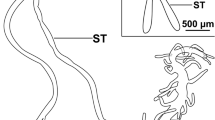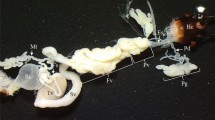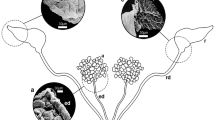Abstract
InPurana tigrina walk. the principal salivary system consists of several digitate lobes which are arranged in two sectors, viz. the cephalic sector and the thoracic sector, corresponding to the anterior and the posterior lobes respectively of the principal salivary gland of a generalised bug. All the lobes of both the sectors are similar in their histology and staining reactions. The accessory salivary system inP. tigrina is unique among insects. It consists of a very long convoluted, collapsible secretory tube which is more than thirty times longer and six times wider than the accessory salivary duct, the junction of the tube and the duct being indicated by a circlet of five binucleate unicellular gular glands. It is suggested that the tube serves the function of secretion and storage of watery saliva and the gular glands secrete certain material which in combination with the watery saliva, serves as stylet sheath forming material thereby favouring the penetration of the stylet fascicle into the hard bark of the stem during feeding operation. The existing fluid pressure in the tube and its collapsible nature are suggestive of the ejection of the fluid through the highly chitinous resistible duct at great force, analogous to the drilling fluid used in mechanical drilling operation.
Similar content being viewed by others
References
Baptist B A 1941 The morphology and physiology of the salivary glands of Hemiptera-Heteroptera;Q. J. Microsc. Sci. 83 91–139
Bronskil J F, Salkeld E H and Friend W G 1958 Anatomy, histology and secretion of the salivary glands of the large milk weed bug,Oncopeltus fasciatus (Dallas) Hemiptera: Lygaeidae;Can. J. Zool. 30 961–968
Goodchild A J P 1952 A study of the digestive system of the West African Cacao Capsid Bug (Hemiptera: Miridae);Proc. Zool. Soc. London 122 543–572
Goodchild A J P 1963a Studies on the functional anatomy of the intestines of Heteroptera;Proc. Zool. Soc. London 141 851–950
Goodchild A J P 1963b Some new observations on the intestinal structures concerned with water disposal in sap-sucking Hemiptera;Trans. R. Entomol. Soc. London B115 217–237
Goodchild A J P 1966 Evolution of the alimentaly canal in the Hemiptera;Biol. Rev. 41 97–104
Livingstone D 1967 On the morphology and Biology ofTingis buddleiae Drake (Heteroptera: Tingidae) Part IV Functional anatomy of the digestive system;J. Animal Morphol. Physiol. 14 170–199
Livingstone D 1969 On the morphology and biology ofTingis buddleiae Drake (Heteroptera: Tingidae) Part II. The functional anatomy of the head;J. Anim. Morphol. Physiol. 16 135–189
Miles P W 1959a The salivary secretions of the plant bug.Oncopltus fasciatus (Dall.) (Heteroptera: Lygaeidae) I. The type of secretion and their roles during feeding;J. Insect Physiol. 3 243–255
Miles P W 1959b The secretion of two types of saliva by an aphid;Nature (London) 183 756
Miles P W 1964a Studies on the salivary physiology of plant bugs: oxidase activity in the salivary apparatus and saliva;J. Insect Physiol. 10 121–129
Miles P W 1964b Studies on the salivary physiology of plant bugs: The chemistry of formation of sheath material;J. Insect Physiol. 10 147–160
Miles P W 1965 Studies on the salivary physiology of plant bugs: The salivary secretions of Aphids;J. Insect Physiol. 11 1261–1268
Miles P W 1967 Studies on the salivary physiology of plant Bugs: Transport from haemolymph to saliva;J. Insect Physiol. 13 1787–1901
Miles P W 1968 Studies on the salivary physiology of plant Bugs: Experimental induction of galls;J. Insect Physiol. 14 97–106
Miles P W 1969 Incorporation and matabolism of cysteine in the haemolymph and saliva of a plant bug;Aust. J. Biol. Sci. 22 1271–1276
Miles P W 1972 The saliva of Hemiptera;Adv. Insect. Physiol. 9 183–255
Miles P W, Mclean D L and Kinsay M G 1964 Evidence that two species of Aphids ingest food through an open stylet sheath;Experientia 20 1–3
Salkeld E H 1959 Histological studies on location and distribution of estrases in the salivary glands of the large milk weed bug,Oncopeltus fasciatus (Dall.) (Hemiptera: Lygaeidae);Can. J. Zool. 37 113–115
Salkeld E H 1960 A histochemical study of the secretions in the principal salivary glands of the large milk weed bug,Oncopeltus fasciatus (Dall.) (Hemiptera: Lygaeidae);Can. J. Zool. 38 449–454
Saxena K N 1963 Mode of ingestion in a Heteropterous insect,Dysdercus koenigii Fabr. (Pyrrhocoridae);J. Insect Physiol. 9 47–71
Southwood T R E 1955 The morphology of the salivary glands of terrestrial Heteroptera (Geocorisae) and its bearing on classification;Tijdschrift voor Entomologis 98 77–84
Author information
Authors and Affiliations
Rights and permissions
About this article
Cite this article
Livingstone, D. On the functional anatomy of the salivary systems ofPurana tigrina Walk. (Homoptera: Cicadidae). Proc. Indian Acad. Sci. 86, 255–263 (1977). https://doi.org/10.1007/BF03050970
Received:
Revised:
Issue Date:
DOI: https://doi.org/10.1007/BF03050970




